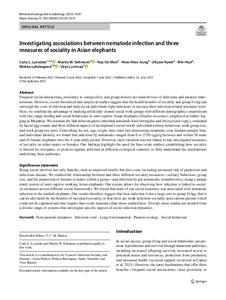Investigating associations between nematode infection and three measures of sociality in Asian elephants
Mon Nay Oo; Lynsdale Carly L; Seltmann Martin W; Nyein UKyaw; Aung Htoo Htoo; Lahdenperä Mirkka; Htut Win; Lummaa Virpi
https://urn.fi/URN:NBN:fi-fe2022081155094
Tiivistelmä
Frequent social interactions, proximity to conspecifics, and group density are main drivers of infections and parasite transmissions. However, recent theoretical and empirical studies suggest that the health benefits of sociality and group living can outweigh the costs of infection and help social individuals fight infections or increase their infection-related tolerance level. Here, we combine the advantage of studying artificially created social work groups with different demographic compositions with free-range feeding and social behaviours in semi-captive Asian elephants (Elephas maximus), employed in timber logging in Myanmar. We examine the link between gastro-intestinal nematode load (strongyles and Strongyloides spp.), estimated by faecal egg counts, and three different aspects of an elephant's social world: individual solitary behaviour, work group size, and work group sex ratio. Controlling for sex, age, origin, time since last deworming treatment, year, human sampler bias, and individual identity, we found that infection by nematodes ranged from 0 to 2720 eggs/g between and within 26 male and 45 female elephants over the 4-year study period. However, such variation was not linked to any investigated measures of sociality in either males or females. Our findings highlight the need for finer-scale studies, establishing how sociality is limited by, mitigates, or protects against infection in different ecological contexts, to fully understand the mechanisms underlying these pathways.
Significance statement
Being social involves not only benefits, such as improved health, but also costs, including increased risk of parasitism and infectious disease. We studied the relationship between and three different sociality measures-solitary behaviour, group size, and the proportion of females to males within a group-and infection by gut nematodes (roundworms), using a unique study system of semi-captive working Asian elephants. Our system allows for observing how infection is linked to sociality measures across different social frameworks. We found that none of our social measures was associated with nematode infection in the studied elephants. Our results therefore suggest that here infection is not a large cost to group living, that it can be alleviated by the benefits of increased sociality, or that there are weak infection-sociality associations present which could not be captured and thus require finer-scale measures than those studied here. Overall, more studies are needed from a diverse range of systems that investigate specific aspects of social infection dynamics.
Kokoelmat
- Rinnakkaistallenteet [19207]
